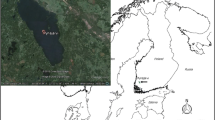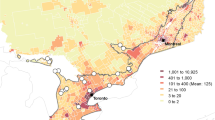Abstract
Eutrophication is often considered to play an important role in reed decline. We decided to use a chronological comparison of the two phenomena as a useful aid in the search for a possible causal relationship between them. Eutrophication is usually documented by changes in phosphorus and nitrogen content in water but there are no such data older than 10 years available for most of the lakes in which reed decline has been observed. The entire historical record of eutrophication has been recently reconstructed from micropaleontological analysis of indicatory diatom frustules, deposited in sediments in three lakes in south Germany. In these lakes, reed decline was well documented by archival aerial photographs. The comparison of reed decline history with the reconstructed changes in water quality confirmed the coincidence of reed decline and eutrophication. Consequently, eutrophication cannot be excluded as a potential cause of reed decline in any lake in this study.
Similar content being viewed by others
References
Alefs J., Müller J. &Lenhart B. (1996): Die jährliche Änderungen der Diatomeenvergesellschaftung seit 1958 in einem warvendatierten Sedimentkern aus dem Ammersee (Oberbayern).Limnological 26: 39–48.
Boar R. R., Crook C. E. &Moss B. (1989): Regression ofPhragmites australis reedswamps and recent changes of water chemistry in the Norfolk Broadland, England.Aquatic Bot. 35: 41–55.
Den Hartog C., Kvêt J. &Sukopp H. (1989): Reed. A common species in decline.Aquatic Bot. 35: 1–4.
Drew M. C. (1990): Sensing soil oxygen.Pl. Cell and Environm. 13: 681–693.
Dykyjová D. &Hradecká D. (1976): Production ecology ofPhragmites communis. 1. Relations of two ecotypes to the microclimate and nutrient conditions of habitat.Folia Geobot. Phytotax. 11: 23–61.
Elster H. J. (1977): Die Eutrophierung unserer Gewässer. In:Haendler H. (ed.)Hundert Jahre Geowissenschaften in Hohenheim. Hohenheimer Arbeiten Nr. 88 (Allgemeine Reihe), Verlag Eugen Ulmer, Stuttgart, pp. 50–66.
Forsberg C (1989): Importance of sediments in understanding nutrient cyclings in lakes.Hydrobiologia 176/177: 263–277.
Granéli W. (1985): Biomass response after nutrient addition to natural stands of reed,Phragmites australis.Verh. Int. Vereinigung Limnol. 22: 2956–2961.
Grimminger H. (1982):Verzeichnis der Seen in Bayern. Bayerisches Landesamt für Wasserwirtschaft, München.
Herbst M. &Kappen L. (1993): Die Rolle des Schilfs im standörtlichen Wasserhaushalt eines norddeutschen Sees.Phytocoenologia 23: 51–64.
Kubín P. &Melzer A. (1996): Does ammonium affect accumulation of starch in rhizomes ofPhragmites australis (Cav.) Trin. exSteud?Folia Geobot. Phytotax. 31: 99–109.
Kubín P., Melzer A. &Ĉížková H. (1994): The relationship between starch content in rhizomes ofPhragmites australis (Cav.) Trin. exSteud. and trophic conditions of habitat.Proc. Roy. Soc. Edinburgh, Ser. B. 102: 433–438.
Kühl H. &Kohl J. G. (1992): Nitrogen accumulation, productivity and stability of reed stands (Phragmites australis (Cav.) Trin. exSteudel) at different lakes and sites of the lake districts of Uckermark and Mark Brandenburg (Germany).Int. Rev. Gesamten Hydrobiol. 77: 85–107.
Lang G. (1973): Die Makrophytenvegetations in der Uferzone des Bodensees unter besonderer Berücksichtigung ihres Zeigerwertes für den Gütezustand. In:Internationale Gewässerschutzkommission für den Bodensee, Bericht Nr. 12. Landessammlungen für Naturkunde in Karlsruhe. Karlsruhe, pp. 1–67.
Lenhart B. (1993): Auswirkungen der Nährstoffenbelastung auf Seen am Beispiel Ammersee.Münchener Beitr. Abwasser- Fischerei- und Flussbiol. 47: 185–205.
Liebmann H. (1965): Nahrstoffanreicherung der Gewässer durch häusliche und industrielle Abwässer, beschrieben am Beispiel des Bodensees.Münchener Beitr. Abwasser-, Fischerei- und Flussbiol. 12: 84–102.
Likens G. E. (1985):An ecosystem approach to aquatic ecology. Mirror Lake and its environment. Springer-Verlag, Berlin.
Mayer S. (1995):Die Röhrichte und Grosseggensümpfe des südlichen Ostereengebietes unterökologischen und pflanzensoziologischen Gesichtspunkten. Thesis, Albert-Ludwigs-Universität Freiburg, Freiburg.
Melzer A., Harlacher R., Held K., Sirch R. &Vogt E.. (1986).Die Makrophytenvegetation des Chiemsees. Informationsberichte, Heft 4/86, Bayerisches Landesamt für Wasserwirtschaft, München.
Melzer A., Harlacher R., Held K. &Vogt E. (1988):Die Makrophytenvegetation des Ammer-, Wörth- und Pilsensees sowie des Wesslinger Sees. Informationsberichte, Heft 1/88, Bayerisches Landesamt für Wasserwirtschaft, München.
Mohaupt K. (1994):Rezente und subrezente Diatomeen im Sediment des Bodensee-Obersees als Abbild der Nährstoffbelastung. Thesis, Universität Konstanz, Konstanz.
Ostendorp W. (1989): “Die-back” of reeds in Europe—a critical review of literature.Aquatic Bot. 35: 5–26.
Ostendorp W. (1990): Die Ursachen des Röhrichtrückgangs am Bodensee-Untersee.Carolinea 48: 85–102.
Ostendorp W. (1992): Shoreline algal wash as a factor in reeds decline in Lake Constance-Untersee.Hydrobiologia 242: 165–174.
Pries E. (1984a) Verlauf, Umfang und Ursachen des Röhrichtrückganges an uckermärkischen Seen und seine Auswirkungen auf Rohrsängerbestände. Teil 1 (Röhrichtrückgang).Naturschutzarbeit Mecklenburg 27: 3–19.
Pries E. (1984b): Verlauf, Umfang und Ursachen des Röhrichtrückganges an uckermärkischen Seen und seine Auswirkungen auf Rohrsängerbestände, Teil 2 (Rohrsängerbestände).Naturschutzarbeit Mecklenburg 28: 72–82.
Raghi-Atri F. &Bornkamm R. (1979): Wachstum und chemische Zusammensetzung von Schilf (Phragmites australis), in Abhängigkeit von der Gewässereutrophierung.Arch. Hydrobiol. 85: 192–225.
Round F. E. (1985):The ecology of algae. Cambridge University Press, Cambridge.
Rücker A. (1993):Der Schilfrückgang am Ammersee. Untersuchungen zur Entwicklung der Röhrichtbestände in Vergangenheit und Gegenwart sowie eine Analyse der möglichen Rückgangsursachen. Thesis. Technische Universität München. München.
Schaumburg J. (1992):Zur Limnologie des Chiemsees. Informationsberichte, Heft 2/92. Bayerisches Landesamt für Wasserwirtschaft, München.
Schröder R. (1987): Das Schilfsterben am Bodensee—Untersee, Beobachtungen, Untersuchungen und Gegenmassnahmen.Arch. Hydrobiol. Suppl. 76: 53–99.
Schubert K. &Barth E. W (1987):Süddeutsche Segelreviere aus der Luft. Delius Klasung Verlag, Bielefeld.
Schwoerbel J. (1993):Einführung in die Limnologie. Gustav Fischer Verlag, Stuttgart, Jena.
Stabel H. H. &Kleiner J. (1995): Folgen der Phosphatabnahme für die Phytoplanktonentwicklung im Bodensee.GWF-Wasser/Abwasser 136: 601–607.
Stark H. &Dienst M. (1989): Dynamics of lakeside reed belts at Lake Constance (Untersee) from 1984 to 1987.Aquatic Bot. 35: 63–70.
Tilzer M. M. &Serruya C. (1990):Large lakes. Ecological structure and function. Springer Verlag, Berlin.
Ulrich K. E. &Burton T. M. (1985): The effects of nitrate, phosphate and potassium fertilization on growth and nutrient uptake patterns ofPhragmites australis (Cav.) Trin exSteudel.Aquatic Bot. 21: 53–62.
Veit E. (1993):Veranderung der Bestandsdichte des Schilfes (Phragmites australis)am Starnberger See und Erfassung des Istzustandes durch biometrische Messungen an ausgewähltens Beständen Thesis, Technische Universität München, München.
Wheeler B. D., Shaw S. C. &Cook R. E. D. (1992): Phytometric assessment of the fertility of undrained rich-fen soils.J. Appl. Ecol. 29: 466–475.
Author information
Authors and Affiliations
Additional information
An erratum to this article is available at http://dx.doi.org/10.1007/BF02821953.
Rights and permissions
About this article
Cite this article
Kubín, P., Melzer, A. Chronological relationship between eutrophication and reed decline in three lakes of southern Germany. Folia Geobot 32, 15–23 (1997). https://doi.org/10.1007/BF02803880
Received:
Revised:
Accepted:
Published:
Issue Date:
DOI: https://doi.org/10.1007/BF02803880




